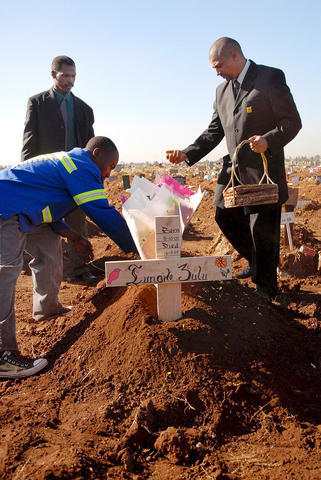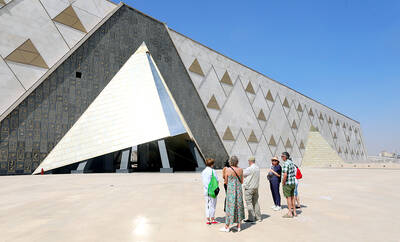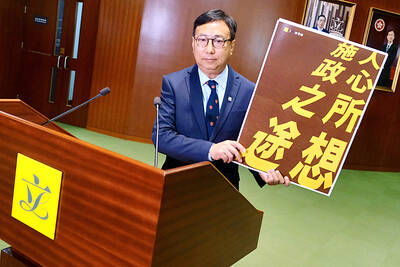Today is Saturday in Soweto and AIDS-ridden South Africa's biggest township is geared up for its foremost weekend activity: funerals.
Traffic police officers are dis-patched en masse to the major streets where the sheer number of funeral processions would render chaos if one had to rely on traffic lights alone.
"Nowadays young people are dying like flies," reflects 27-year-old Modise Selebogo as the family of a close friend throws soil on the grave at Avalon Cemetery, Soweto's biggest burial ground.

PHOTO: EPA
Music from another funeral not 3m away wafts over to intersperse with singing at this graveside, where a young male victim of the AIDS pandemic joins thousands of others below the soil.
Freshly covered mounds creep towards the edge of the cemetery where many heroes of South Africa's liberation struggle were buried and several freshly-dug graves wait for funerals later in the day.
South Africa, which recent UN data say has the world's worst rate of HIV sufferers, is experiencing soaring death rates -- mostly among young people -- resulting in overcrowded cemeteries and weekends spent attending funerals.
These funerals are good business for the hundreds of burial companies that advertise on walls lining the streets, with the graveside ceremony over in a matter of minutes as others wait in line.
"Nowadays the tents have to go somewhere else and the buses also. They have to be somewhere at another funeral. The hearse also," says Selebogo.
About 45km south of Johannesburg lies South Africa's biggest informal settlement, Orange Farm, where circumcision studies were first found to decrease risk of being infected with HIV.
Here Reverend Gijimane Radebe who has worked at the St Augustine parish for four years, can attest to the dreadful impact AIDS has had on the community, as well as himself.
"It's killing young people terribly. I have buried almost every week, young people between the ages of 18 and 40," he said.
"When you go around in churches you find priests talking about burying so many young people in the community."
He said he and other pastors were regularly debriefed by the diocese "because they know the stress we are working under. It affects you sometimes".
In African culture a funeral is a big occasion, necessitating the slaughter of a cow and the best coffin and after-burial banquet money can buy.
The cruel extent of the AIDS pandemic means that families may still be reeling from the death of one loved one when they have to bury another.
"I have encouraged our parishioners not to spend a lot on funerals. In the African way we have to slaughter a cow and prepare food -- you end up spending about 20,000 rand [US$3,000]," Radebe said.
"In other families people are dying in numbers and it's hard to bury them all," he said.
However while some could not be spared the embarrassment of a pauper's funeral, having to borrow money from other members of the congregation, most could not be dissuaded from sending their family members off in style.
"People, they will tell you: `What will my neighbors say?' People end up being in debt for something they could have avoided," he said.
South Africa has some 5.5 million people out of a population of 48 million living with HIV, and a recent report by the Institute of Race Relations showed how the pandemic has affected the country.
"Deaths in the 30 to 34 age group increased by 212 percent between the years of 1997 and 2005," the report said.
While AIDS was not a cause of death that could be written on a death certificate the report found deaths due to tuberculosis and pneumonia suggest many of these deaths "have an HIV component."
Orange Farm resident Lucy Skosana, 46, a domestic worker in Johannesburg, notes how times have changed.
"When I grew up we never used to go to funerals," she says, adding that now, she could attend several funerals on any given Saturday.
At Avalon cemetery there are between 250 and 275 funerals a week, and the City of Johannesburg is having to explore other options, including the opening of new cemeteries.
Trying to get people to cremate their family members, which is not considered customary in African culture, has proved "a challenge," said Alan Buff, technical support specialist for Johannesburg City Parks.
He said the city was currently providing options for families to buy a burial space and for a reduced cost to bury a second or third person in the same grave.
"It is not unusual, they do it in the United Kingdom. It saves a lot of space," he said.

With much pomp and circumstance, Cairo is today to inaugurate the long-awaited Grand Egyptian Museum (GEM), widely presented as the crowning jewel on authorities’ efforts to overhaul the country’s vital tourism industry. With a panoramic view of the Giza pyramids plateau, the museum houses thousands of artifacts spanning more than 5,000 years of Egyptian antiquity at a whopping cost of more than US$1 billion. More than two decades in the making, the ultra-modern museum anticipates 5 million visitors annually, with never-before-seen relics on display. In the run-up to the grand opening, Egyptian media and official statements have hailed the “historic moment,” describing the

‘CHILD PORNOGRAPHY’: The doll on Shein’s Web site measure about 80cm in height, and it was holding a teddy bear in a photo published by a daily newspaper France’s anti-fraud unit on Saturday said it had reported Asian e-commerce giant Shein (希音) for selling what it described as “sex dolls with a childlike appearance.” The French Directorate General for Competition, Consumer Affairs and Fraud Control (DGCCRF) said in a statement that the “description and categorization” of the items on Shein’s Web site “make it difficult to doubt the child pornography nature of the content.” Shortly after the statement, Shein announced that the dolls in question had been withdrawn from its platform and that it had launched an internal inquiry. On its Web site, Le Parisien daily published a

China’s Shenzhou-20 crewed spacecraft has delayed its return mission to Earth after the vessel was possibly hit by tiny bits of space debris, the country’s human spaceflight agency said yesterday, an unusual situation that could disrupt the operation of the country’s space station Tiangong. An impact analysis and risk assessment are underway, the China Manned Space Agency (CMSA) said in a statement, without providing a new schedule for the return mission, which was originally set to land in northern China yesterday. The delay highlights the danger to space travel posed by increasing amounts of debris, such as discarded launch vehicles or vessel

RUBBER STAMP? The latest legislative session was the most productive in the number of bills passed, but critics attributed it to a lack of dissenting voices On their last day at work, Hong Kong’s lawmakers — the first batch chosen under Beijing’s mantra of “patriots administering Hong Kong” — posed for group pictures, celebrating a job well done after four years of opposition-free politics. However, despite their smiles, about one-third of the Legislative Council will not seek another term in next month’s election, with the self-described non-establishment figure Tik Chi-yuen (狄志遠) being among those bowing out. “It used to be that [the legislature] had the benefit of free expression... Now it is more uniform. There are multiple voices, but they are not diverse enough,” Tik said, comparing it